How Gravitational Waves Work (Infographic)

Einstein's general theory of relativity suggests, among other things, that masses in space distort the geometry of space-time. In addition, moving objects emit waves of gravitational radiation that carry energy away into space.
Main Story: Major Discovery: 'Smoking Gun' for Universe's Incredible Big Bang Expansion Found
Gravity is the weakest of the fundamental forces, and the effects of gravitational waves are also weak. The waves squeeze and stretch space as they pass, but the effect is sub-atomically small.
Big Bang Theory: 5 Weird Facts About Seeing the Universe's Birth
The effects of gravitational waves had been observed indirectly by studying binary pulsars. These are pairs of dense neutron stars that orbit each other. As they orbit, they disturb the space-time around them. They give off energy in the form of gravitational waves. This loss of energy causes the neutron stars’ orbits to decay. The decrease in orbital speed can be detected from Earth.
Related: Cosmic Inflation: How It Gave the Universe the Ultimate Kickstart (Infographic)
In 2014, the Harvard-Smithsonian Center for Astrophysics announced the first direct evidence for gravitational waves. By examining the map of Cosmic Microwave Background radiation, astronomers found a faint but distinctive curling pattern. This pattern is thought to have been generated by gravitational waves when the universe inflated a tiny fraction of a second after the Big Bang.
- Images: Peering Back to the Big Bang & Early Universe
- 7 Surprising Things About the Universe
- The Origin, History, Evolution & Future of the Universe
Follow us @Spacedotcom, Facebook and Google+.
Join our Space Forums to keep talking space on the latest missions, night sky and more! And if you have a news tip, correction or comment, let us know at: community@space.com.
Get the Space.com Newsletter
Breaking space news, the latest updates on rocket launches, skywatching events and more!

Karl's association with Space.com goes back to 2000, when he was hired to produce interactive Flash graphics. From 2010 to 2016, Karl worked as an infographics specialist across all editorial properties of Purch (formerly known as TechMediaNetwork). Before joining Space.com, Karl spent 11 years at the New York headquarters of The Associated Press, creating news graphics for use around the world in newspapers and on the web. He has a degree in graphic design from Louisiana State University and now works as a freelance graphic designer in New York City.